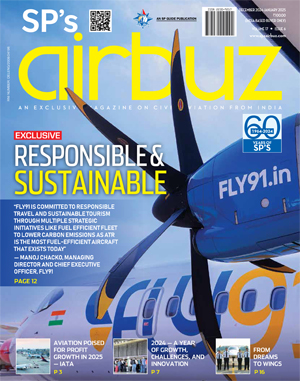Tata Re-enters with Renewed Vigour
Hopefully the reviving economy would help the government rationalise its policies towards aviation. What is certain is that Tata’s re-entry would definitely benefit aviation professionals which should be good enough reason to cheer this aggressive re-entry by Tatas.

Immediately following the relaxation in foreign direct investment (FDI) norms by the government, on February 19, 2013, AirAsia announced a joint venture (JV) airline to be called AirAsia India. Partners in the JV are AirAsia (49 per cent), Tatas (30 per cent) and Arun Bhatia’s Telstra Tradeplace (21 per cent). The JV was cleared in April 2013 by the Foreign Investment Promotion Board (FIPB) and a no objection certificate (NOC) was obtained from the Ministry of Civil Aviation (MoCA) in September 2013. The airline is now awaiting air operator’s permit from the Directorate General of Civil Aviation (DGCA). As per the letter of intent, the airline has the basic organisation in place and was planning to launch operations end 2013. This has been delayed. As on January 13, 2014, the DGCA issued a public notice inviting objections or suggestions with regard to the letter of intent (LOI) submitted by AirAsia India. A statement dated January 16, 2014, by MoCA, indicates that the airline would be cleared by end of February 2014.
In the meantime, on September 19, 2013, a joint statement by Tata Sons and Singapore Airlines (SIA) appeared in the media stating, “Tata Sons and SIA have signed a memorandum of understanding and applied for FIPB approval to establish a new airline in India that will help further stimulate demand for air travel.” Shareholding in this new airline, called Tata SIA Ltd, is 51 per cent by Tata Sons and 49 per cent by SIA, with an initial equity capital investment of $100 million. FIPB approval for the airline has been received and the application for NOC was submitted in December 2013.
Tata Sons believes that “civil aviation in India offers sustainable growth potential”. Prasad Menon, Board Chairman of Tata- SIA airlines, stated, “We are delighted to partner in this endeavour with SIA as it provides the opportunity to launch a worldclass full service airline in India.” This airline would be a full service carrier (FSC) based out of Delhi and would commence operations with 20 leased Airbus A320s. AirAsia India, on the other hand, is a low-cost carrier (LCC) based out of Chennai and will commence operations with five AirAsia owned/leased A320s.
AirAsia India
As per the letter of intent submitted by AirAsia India to the DGCA, the company’s main base would be Chennai with Bengaluru, Trichy, Madurai, Coimbatore, Cochin, Hyderabad, Goa, Ahmedabad, Jaipur and Pune as the line bases. The AirAsia group is already operating to four of these locations. In addition, the group is operating to Kolkata. As of January 14, 2014, the AirAsia group is connecting these five bases, viz Bengaluru to one destination in Malaysia; Kolkata to five destinations in three countries; Kochi to 13 destinations in seven countries; Chennai to 12 destinations in seven countries and Trichy to two destinations in two countries.
Considering the set up, it is a given, that AirAsia India would have an agreement with the AirAsia group. This would enable the AirAsia group airlines to access more destinations in India with the help of AirAsia India, without having to establish additional bases in India. It is highly probable that AirAsia India would operate as a seamless feeder for the other AirAsia group airlines in the domestic segment in addition to carrying purely domestic passengers of its own. In case this is managed well, the airline can expect decent load factors. This is a win-win arrangement for AirAsia India and the other AirAsia group airlines.
The AirAsia group operates to destinations towards the east of India, from China to Australia and right up to Japan. As of now, roughly 70 per cent of the traffic emanating from India travels westwards mainly to North America, West Asia, UK, South Africa and Europe. In view of the ‘Look East’ policy of the Indian Government, more and more Indians now have disposable incomes for leisure travel. Besides, there are tourist-friendly countries in this region and the steep depreciation of the rupee is likely to make Eastern destinations more attractive for leisure travel. These factors will be to AirAsia India’s advantage.
Tata-SIA Airlines
Singapore is a small city-state and thus SIA by necessity, is a totally international airline. SIA is always looking to expand to greener pastures and what better place than India, with its huge population. SIA CEO Goh Choon Phong stated that “we have always been a strong believer in the growth potential of India’s aviation sector. Tata Sons is one of the most established and respected names in India. With the recent liberalisation, the time is right to jointly bring consumers a fresh new option for full service air travel. We are confident the joint venture airline will help to stimulate market demand and provide economic benefits to India”. Here it may be worthwhile to evaluate the performance of Indian full service carriers.
The track record indicates that things have not been good, especially during the past few years. Of the three FSCs, Kingfisher has shut down because of depletion of working capital and accumulation of huge losses. Jet Airways has been consistently making losses and is in the process of selling part of its stake to Etihad. Due to constant losses, Air India has also been on constant life support. The two operating FSCs, viz Air India and Jet Airways, have incurred a loss of more than 5,500 crore for fiscal year 2012-13. Even the LCCs, excluding IndiGo, have been bleeding. All this indicates that in a value-sensitive market like India, the number of customers willing to pay for full service does not appear to be adequate for profitability. How then does the Tata-SIA airline visualise making a profit? A look at the SIA model may provide some answers.
SIA caters to various passenger requirements—long-haul international operations by Singapore Airlines; regional flights within the region and to India by FSC SilkAir, a wholly-owned subsidiary of SIA and low-cost medium and long-haul flights through its wholly-owned subsidiary Scoot. SIA also has a 32.84 per cent stake in budget carrier Tigerair. Both SilkAir and Tigerair operate the A320. Considering that Tata-SIA plans to start operations with the A320, it is logical to assume that the operations of Tata-SIA would be on the lines of SilkAir. The latter operates to 42 destinations in 12 countries in the region that includes India, China and ten other countries of South East Asia. SilkAir operates to eight cities in India that includes Kolkata, Hyderabad and other cities in South India.
SIA caters to various passenger requirements—long-haul international operations by Singapore Airlines; regional flights within the region and to India by FSC SilkAir, a wholly-owned subsidiary of SIA and low-cost medium and long-haul flights through its wholly-owned subsidiary Scoot. SIA also has a 32.84 per cent stake in budget carrier Tigerair. Both SilkAir and Tigerair operate the A320. Considering that Tata-SIA plans to start operations with the A320, it is logical to assume that the operations of Tata-SIA would be on the lines of SilkAir. The latter operates to 42 destinations in 12 countries in the region that includes India, China and ten other countries of South East Asia. SilkAir operates to eight cities in India that includes Kolkata, Hyderabad and other cities in South India.
Tata’s Strategic Intent
With all this, Tatas are attempting to straddle both the basic strategies that are followed by airlines globally. One strategy is that of a LCC focused on providing safe and cheap transportation by air. As the name implies, these are airlines that are completely cost driven; are single class with ‘no-frills’; which earn a significant part of their revenue through ancillary services and which succeed because of high occupancy on account of low fares. The other strategy is that of an FSC that goes beyond cheap and safe transportation and offers additional premium services to business and discerning frequent travellers. These services include different classes of travel, frequent flier programmes, food and beverages, audio and video entertainment systems with free headphones.
In the past decade, established FSCs like Qantas, Jet Airways and SIA were compelled to follow this two-pronged strategy due to the existential threat from the success of LCCs. These are only three examples of the many legacy carriers that have adopted this strategy globally. These three airlines started their own wholly-owned LCC subsidiaries named Jetstar, JetLite and Scoot respectively, after having established themselves in the aviation industry as FSCs. Tatas, on the other hand, are entering the aviation industry after a long gap. They have taken a very aggressive decision to cater to the entire range of air travellers by establishing joint ventures with a LCC like AirAsia at the nofrills end, and an FSC like SIA at the full service end. However, it is to the credit of the Tatas that partners in both the JVs are established players in the field and represent the best in aviation in South East Asia.
Questions Remain
Questions are still being raised about how Tatas would manage two diverse JV airline projects with partners that are rivals in the region. This can best be answered by a tweet from Tony Fernandes on September 28, 2013, which says, “I have and continue to have no issue on SIA and Tatas. No different to Ginger and Taj hotels. These are two very separate businesses.” Also, except for IndiGo, most airlines in India are making losses irrespective of whether they are FSCs or LCCs. Some of the reasons for the losses are exorbitant fuel prices, high airport charges, government policies like route dispersal guidelines, value conscious clientele and a subsidised countrywide rail network.
Airlines in India are able to operate to fewer than 100 domestic destinations due to infrastructural constraints. Besides, airlines are a hugely capital-intensive business with a high fixed-cost that is coupled with the fact that airline seats are perishable. Empty seats and passenger load factors are an airline’s nightmare globally. Patience and deep pockets should see the Tatas through the very challenging period initially. Thereafter, hopefully the reviving economy would help the government rationalise its policies towards aviation. What is certain is that Tatas’ re-entry would definitely benefit aviation professionals which should be good enough reason to cheer this aggressive re-entry by Tatas.





